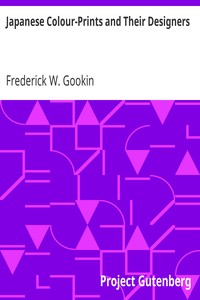| Summary |
"Japanese Colour-Prints and Their Designers" by Frederick W. Gookin is a comprehensive examination of the Ukiyoé school of printmaking, delivered as a lecture before the Japan Society in New York in 1911 and published in the early 20th century. This scholarly work focuses on the unique and significant contributions of various designers to the art of Japanese color prints, depicting themes prevalent in the contemporary lives of people during Japan's Edo period. Gookin offers insights into the cultural and social contexts that influenced these works, positioning them as an essential part of Japan's artistic heritage. The book delves into the evolution of Japanese color-printing from its origins in the 17th century through its peak in the 18th century, highlighting notable artists such as Moronobu, Harunobu, and Hiroshige. Gookin outlines the technical processes involved in printmaking, including the progression from simple black outlines to intricate multi-color prints, and discusses the thematic focus on daily life, theater, and landscapes. The text serves both as a historical account and an analysis of aesthetic principles, emphasizing the interplay between popular art and societal hierarchies, while also tackling the underappreciation of Ukiyoé by the elite in Japan at the time. Overall, Gookin's work provides a captivating look at how these prints encapsulated the fleeting moments of life in Japan and have gained enduring admiration in the art world. (This is an automatically generated summary.)
|

